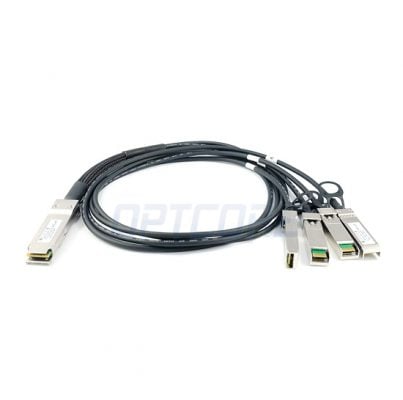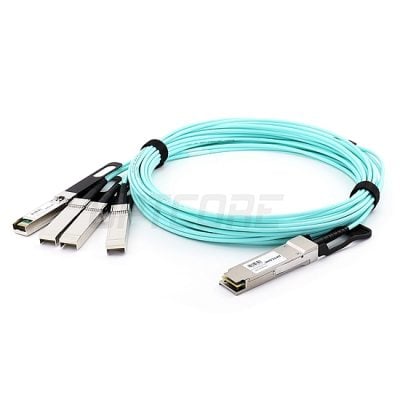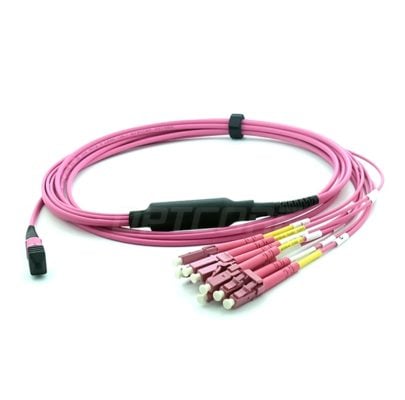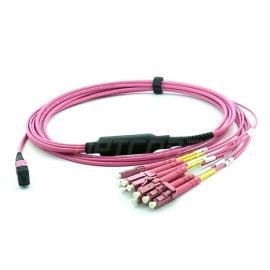Blog, Network Cabling, Optical Transceiver
What is Breakout Cable? Everything You Need to Know
Breakout cables achieve robust connectivity between network devices with multiple speed ports. They gather numerous optical fibers or copper wires into a jacket broken down into separate connectors. They can fully tap the potential of port bandwidth, offering practical solutions for enhancing network connections.
This article will help you discover the definition, various types, pros and cons, and choosing methods regarding such cables.
Table of contents
Breakout Cable Definition
You can find the column “Products” in the upper left corner when accessing our official website. Once you move your mouse onto the DAC/AOC Cable, you will see the Breakout DAC Cable and the Breakout AOC Cable simultaneously. But what do these words stand for? Let’s start with the exact meaning of fanout cables.
Breakout cables, also called fanout cables, combine or separate copper wires or optical fibers into a jacket that “breaks out” into many individual connectors. Using them can make network connections optimal and streamlined. With the help of fanout cables, you break down many connections into one channel to simplify installation, reduce cable congestion, and manage cables well.
Breakout mode forms when high-speed channelized ports on a network element break into many low-speed ports, each linking multiple network elements. For example, a switch with 200G ports can be connected to 50G or 100G ports.
Breakout Cable Types
This section offers the answer to the question posed in the beginning. Fanout cables have various types to cater to the specific requirements of networking devices. The main types include breakout DACs, AOCs, and fiber breakout cables.

Breakout DACs
The full name is direct attach cable. They are fixed in length and are made of multiple copper Twinax cables. For instance, the QSFP+ breakout cable on our website is 1 meter long in passive configuration. You can look through a wide selection of our breakout DACs, including 40G QSFP+, 100G QSFP28, 100G QSFP28, and 400G QSFP-DD.
Optcore Breakout DACs
-
0.5~2m Generic Compatible 800G OSFP Finned Top to 2x 400G OSFP Finned Top Breakout DAC Cable
Price range: US$ 139.00 through US$ 219.00 (Excl. VAT) -
0.5~2m Generic Compatible 800G OSFP Finned Top to 4x 200G OSFP Flat Top Breakout DAC Cable
Price range: US$ 169.00 through US$ 239.00 (Excl. VAT) -
0.5m (2ft) Nvidia Ethernet MCP7Y00-N00A Compatible 800G OSFP Finned Top to 2x 400G OSFP Flat Top Breakout DAC
US$ 139.00 (Excl. VAT) -
1m (3ft) Nvidia Ethernet MCP7Y50-N001 Compatible 800G OSFP Finned Top to 4x 200G OSFP Flat Top Breakout DAC
US$ 199.00 (Excl. VAT) -
1.5m (5ft) Nvidia Ethernet MCP7Y50-N01A Compatible 800G OSFP Finned Top to 4x 200G OSFP Flat Top Breakout DAC
US$ 219.00 (Excl. VAT) -
2m (7ft) Nvidia Ethernet MCP7Y50-N002 Compatible 800G OSFP Finned Top to 4x 200G OSFP Flat Top Breakout DAC
US$ 239.00 (Excl. VAT)
Breakout AOCs
The full name is breakout active optical cable. They are fixed-length (typically 1-25 meter long), made of many optical fibers. They consist of the modules that plug into the equipment ports, as shown in Figure 2. Our one-stop store can supply different breakout AOCs, such as 40G QSFP+, 100G QSFP28, and 200G QSFP56.

Optcore Breakout AOCs
-
Arista AOC-Q-4S-100G-1M Compatible 1m (3ft) 100G QSFP28 to 4x25G SFP28 Breakout AOC
US$ 150.00 (Excl. VAT) -
Arista AOC-Q-4S-100G-3M Compatible 3m (10ft) 100G QSFP28 to 4x25G SFP28 Breakout AOC
US$ 153.00 (Excl. VAT) -
Arista AOC-Q-4S-100G-10M Compatible 10m (33ft) 100G QSFP28 to 4x25G SFP28 Breakout AOC
US$ 161.00 (Excl. VAT) -
Arista AOC-Q-4S-100G-15M Compatible 15m (49ft) 100G QSFP28 to 4x25G SFP28 Breakout AOC
US$ 167.00 (Excl. VAT) -
Brocade 100G-QSFP-4SFP-AOC-0101 Compatible 1m 100G QSFP28 to 4xSFP28 Breakout AOC
US$ 157.00 (Excl. VAT) -
Brocade 100G-QSFP-4SFP-AOC-0301 Compatible 3m 100G QSFP28 to 4xSFP28 Breakout AOC
US$ 161.00 (Excl. VAT)
Fiber Breakout Cables
If classified by fiber type, single-mode and multimode are the two types. Our website has a wide range of MTP®/MPO breakout cables for high-density fiber systems, such as data center and telecommunications applications. This series includes singlemode, OM3, OM4, and OM5 fiber cables.

Singlemode cables are suitable for long-distance transmissions, while multimode cables fit the needs of short- to medium-range connections. You can see some of our MTP®/MPO products.
MTP®/MPO Breakout Cables
-
MPO Female to LC Fiber Breakout Cable, 8 Fiber 9/125 Singlemode OS2, Type B, LSZH
Price range: US$ 22.00 through US$ 96.20 (Excl. VAT) -
MPO Female to 4 LC Duplex Fiber Breakout Cable, 8 Fiber 50/125 Multimode OM3, Type B, LSZH
Price range: US$ 25.00 through US$ 223.00 (Excl. VAT) -
MTP® Female to 4xLC Duplex 50/125 Multimode OM4 Fiber Optic Harness Cable, Polarity B, LSZH
Price range: US$ 35.00 through US$ 62.00 (Excl. VAT) -
MTP® Female to 4xLC Duplex 50/125 Multimode OM3 Fiber Optic Harness Cable, Polarity B, LSZH
Price range: US$ 32.00 through US$ 49.00 (Excl. VAT) -
Juniper MTP-4LC-S3M Compatible MTP to 4x LC Duplex Single mode Breakout Fiber Cable
US$ 38.00 (Excl. VAT) -
Juniper MTP-4LC-S5M Compatible MTP to 4x LC Duplex Single mode Breakout Fiber Cable
US$ 40.00 (Excl. VAT)
Merits and Demerits of Breakout Cables
Merits
Simplified Installation and Flexibility: Breakout cables make network design more flexible and installation simpler. This is due to their function of reducing the number of wires needed. When space is very limited in high-density settings, these cables come in handy and are quite essential.
Efficient Use of Network Resources: Owing to the combination of multiple fibers or copper wires into a single cable, breakout cables have greater flexibility in managing and distributing bandwidth. Large data centers, telecommunications, and corporate networks urgently need these cables to ensure the network is scalable and has high performance.
Connectivity Issues Solving: This is because fanout cables can help with cable management in an orderly manner. As cable clutter reduces in quantity and visibility enhances, network operators find it much quicker to detect and handle connectivity problems.
Demerits
Lack of Suitable Replacements: If one of the ports on DAC or AOC cannot work well, it needs to be replaced with the whole cable bundle.
Not as customizable: A QSFP-only port in breakout mode may need to consider a group-wise approach, where a transceiver or cable’s interfaces share the same type.
How to Select the Right Breakout Cables
Many factors need considering when you rightly choose breakout cables. These include the following five aspects. But you should know your requirement first.
Bandwidth Capacity: As a key factor, bandwidth capacity allows you to successfully select the cable types you need. With the correctly chosen cables, you can cause less damage to network performance when handling data traffic.
Connector Types: LC (Lucent Connector), SC (Subscriber Connector), and MPO (Multi-fiber Push-On) are common connector types that match breakout cables. Apart from easy operation and a clear understanding of port density requirements, you should think about whether these cables are compatible with network devices.
Distance Requirements: Breakout DACs, AOCs, and fiber cables suit the demands of different distance transmissions. When choosing the right types, you had better check the distance requirements of your network devices.
Environmental Conditions: During the installation, you should care about their durability, flexibility, and bend radii. Engineers design fanout cables with high performance to fight against severe environmental conditions.
Application Scenarios: Different breakout cable types have their separate use cases. Data centers usually use MPO cables for high-density environments. However, LC cables are better for point-to-point connections in enterprise networks.
Conclusion
Breakout cables have been playing a key role in network connectivity. They also open new ways for technicians to meet the growing bandwidth demand. A better grasp of their types, merits, and demerits, as well as choosing methods, can help you decide which cable suits your needs.
Reference
Read More
- What is DAC Cable? The Definitive Guide
- Introduction to 100G QSFP28 DAC Cable
- What is the difference between DAC and AOC Cables












